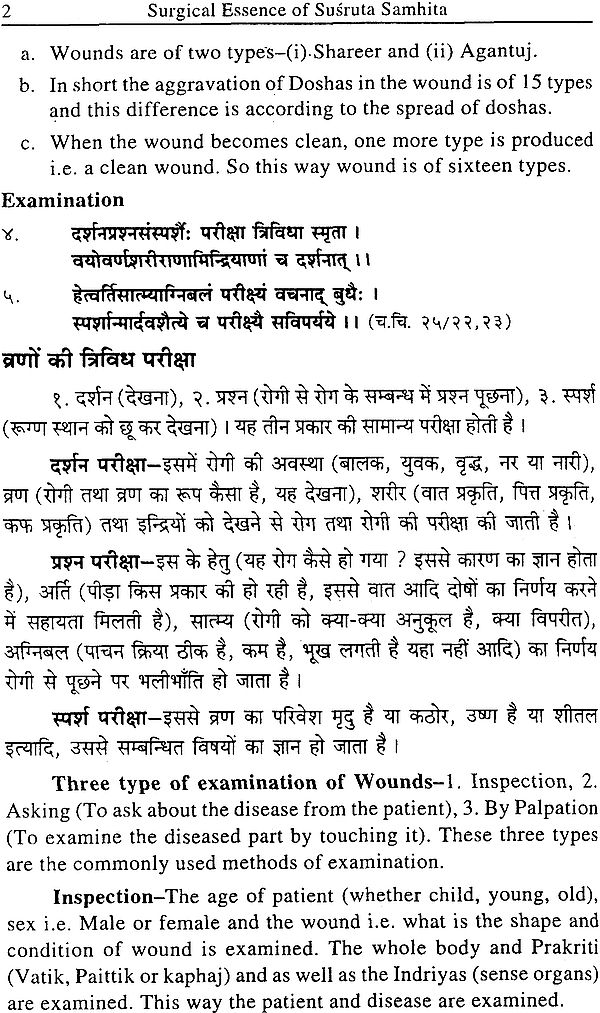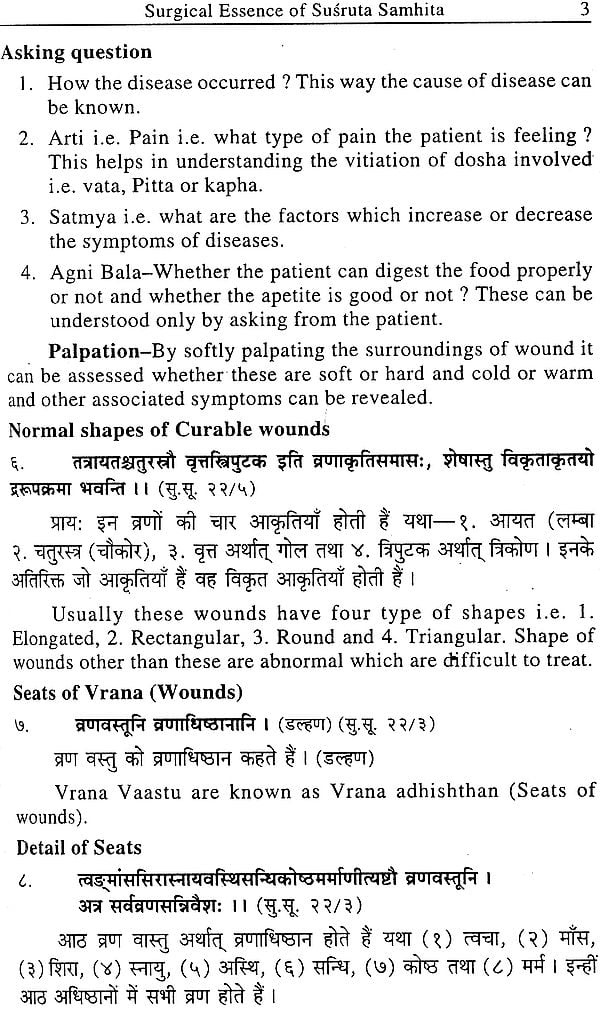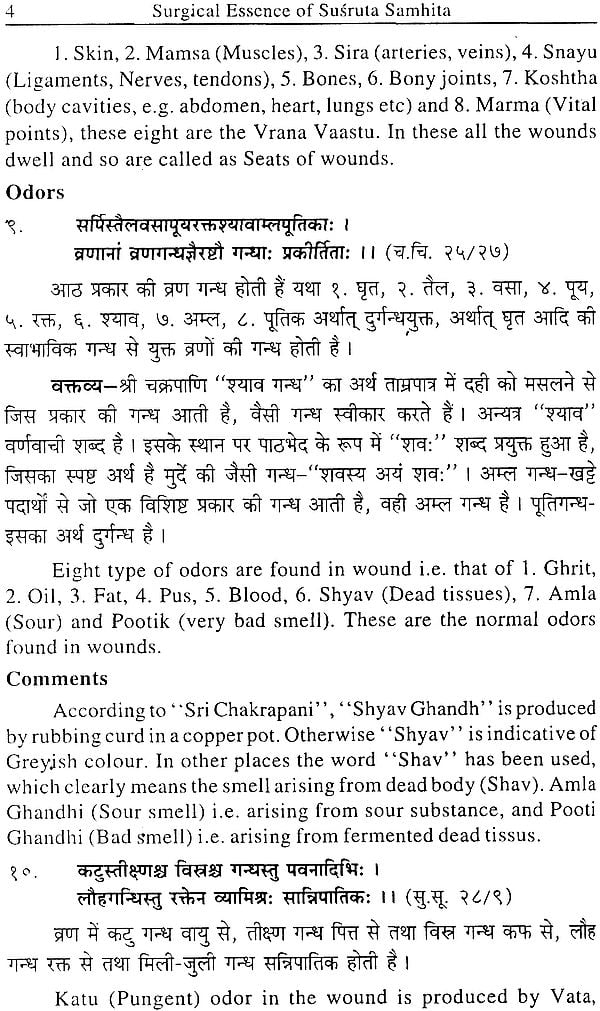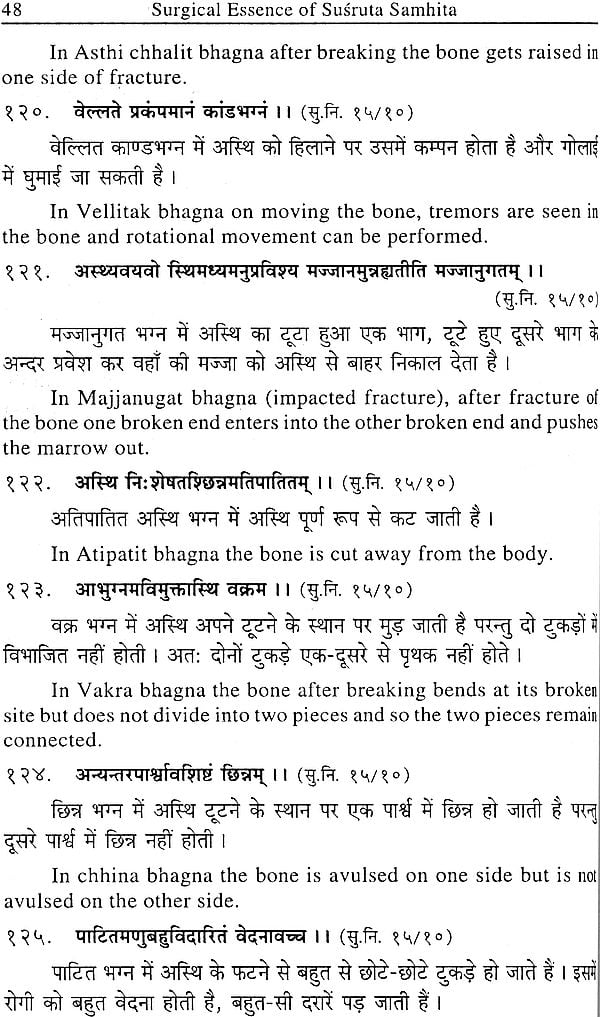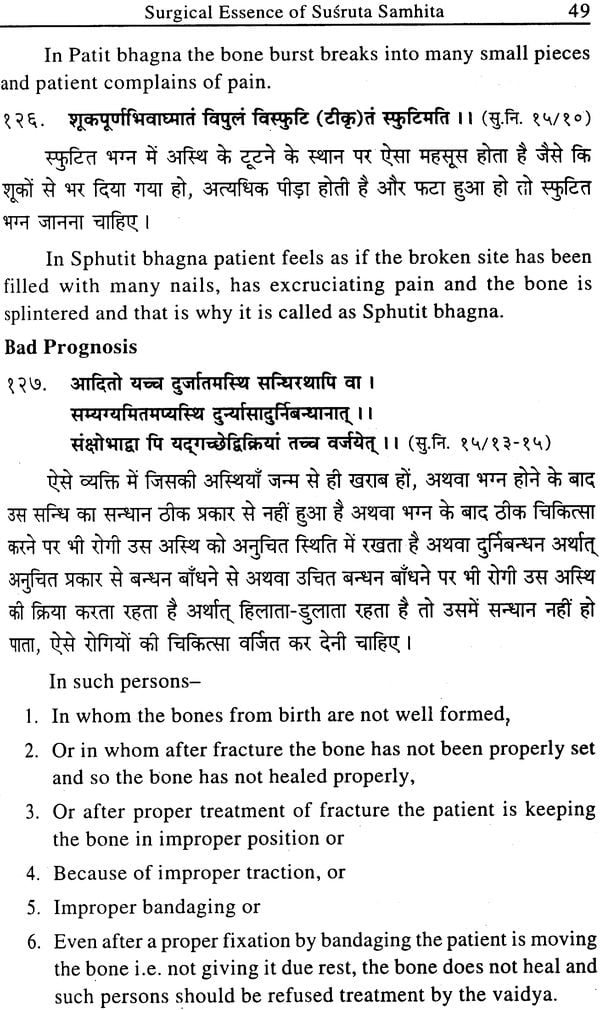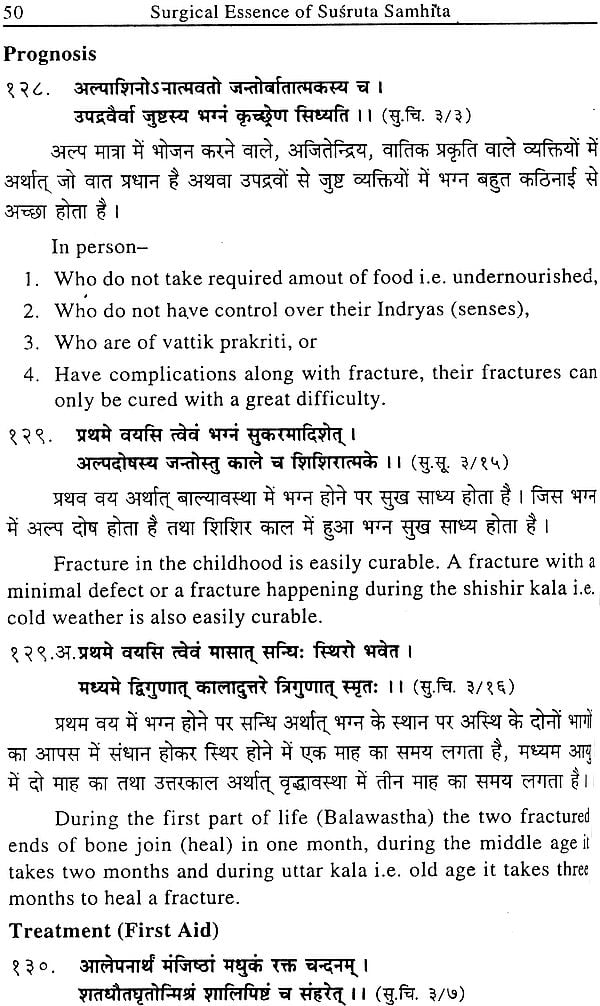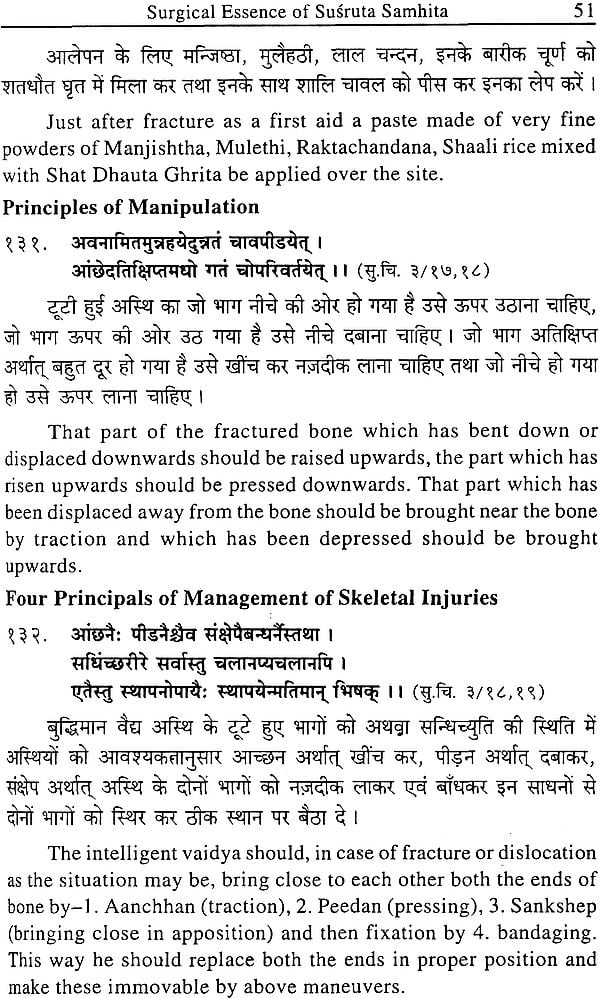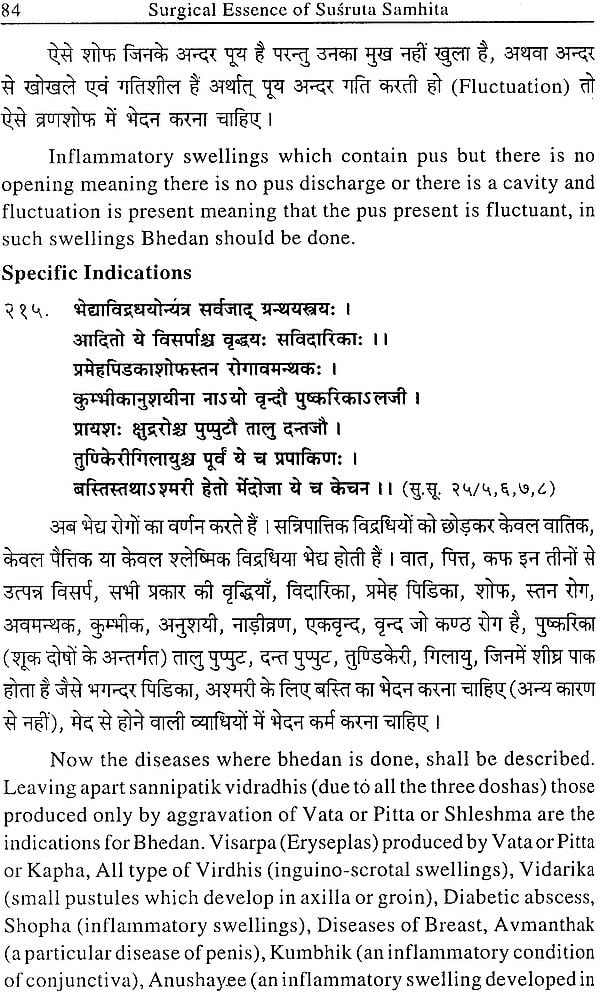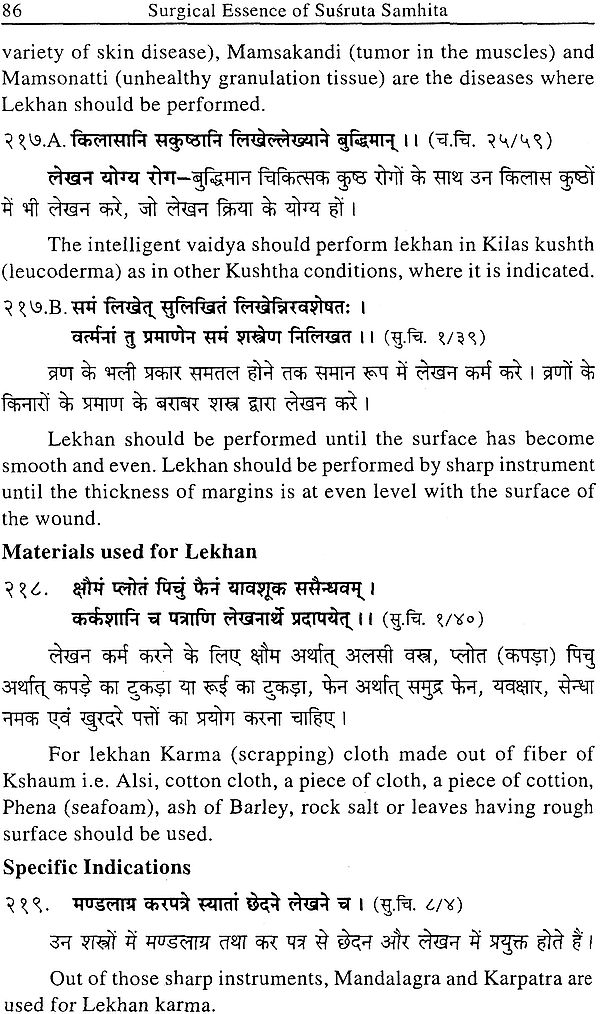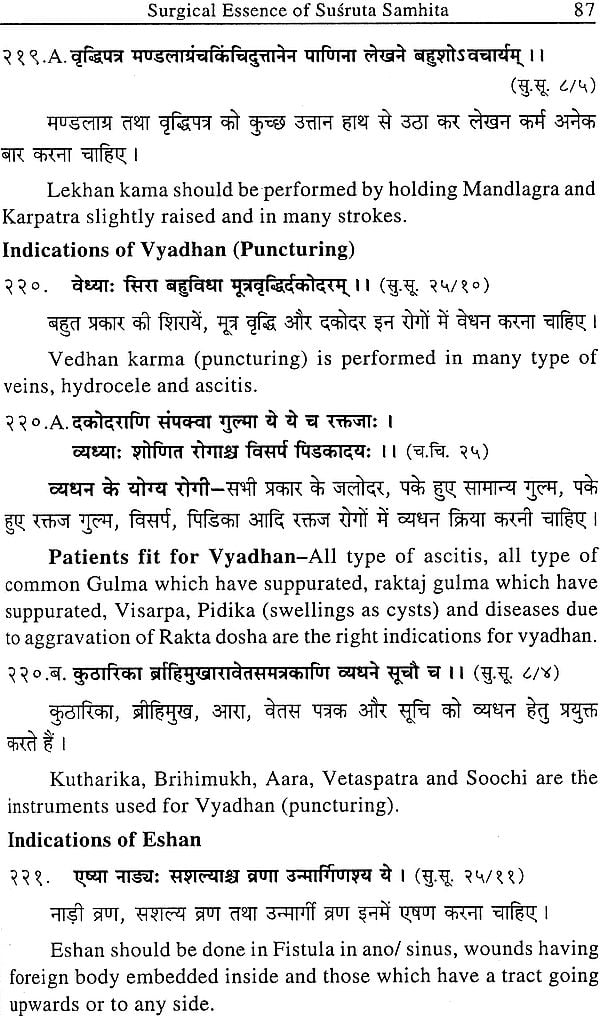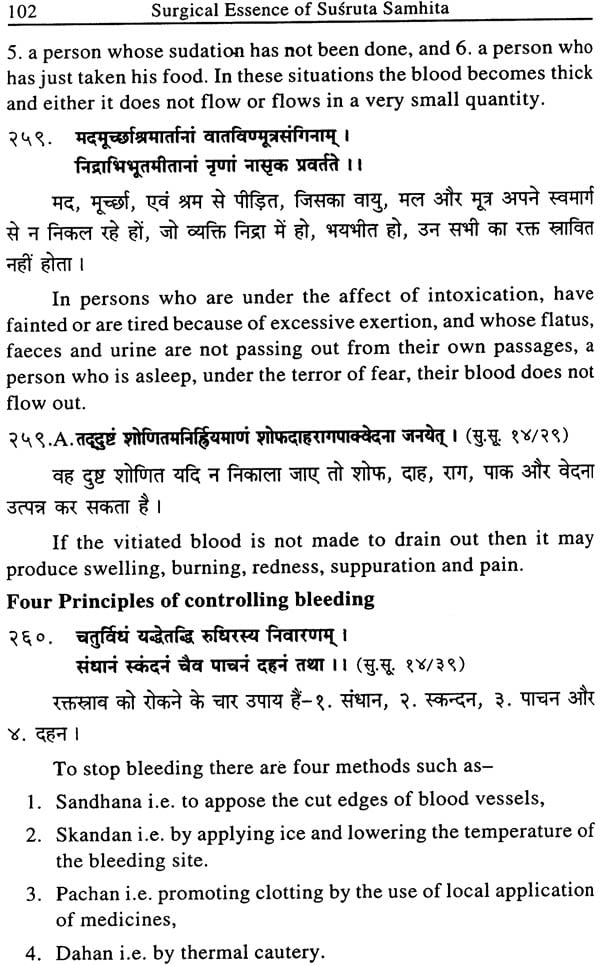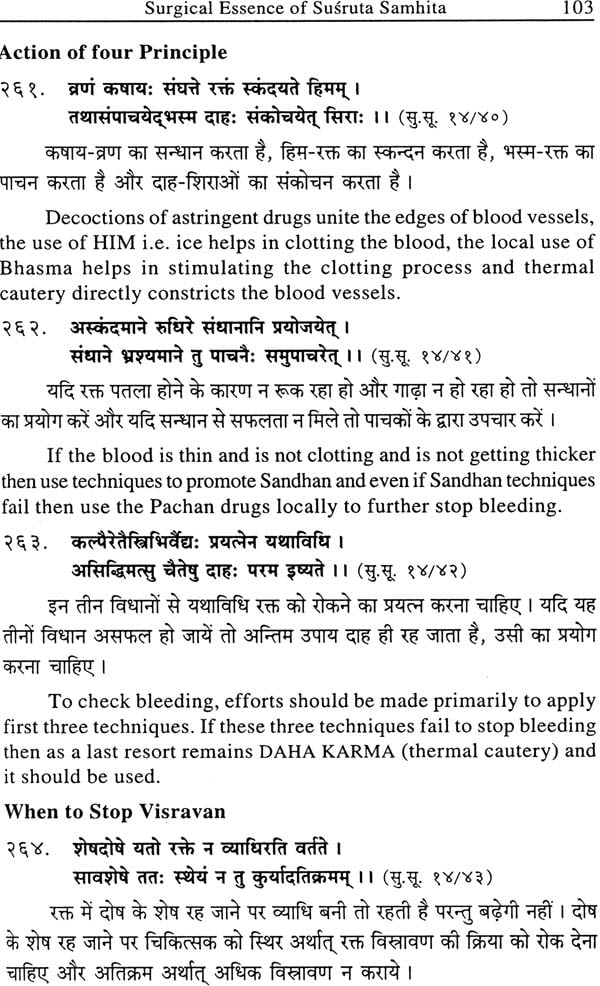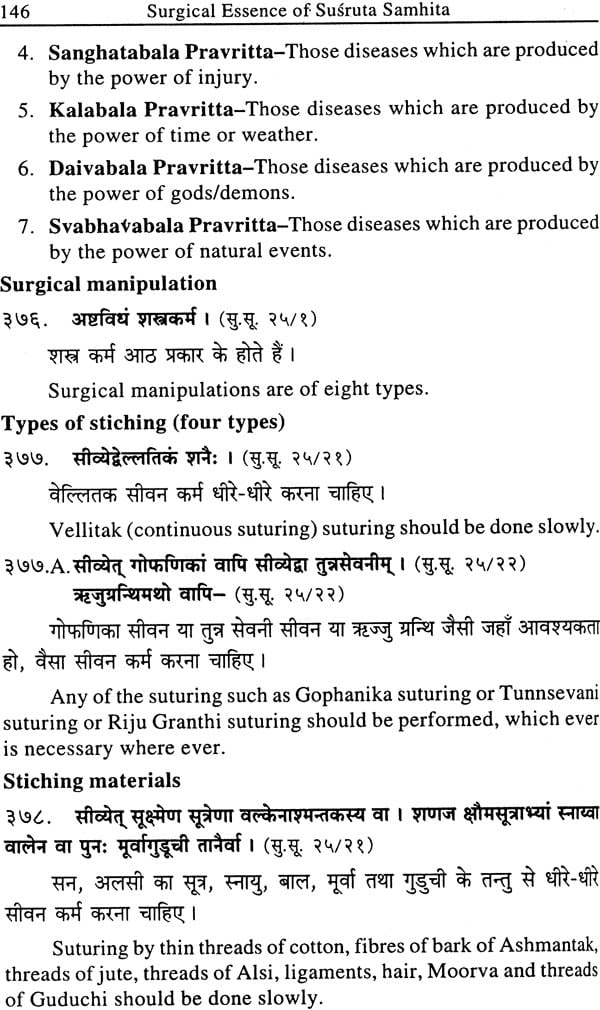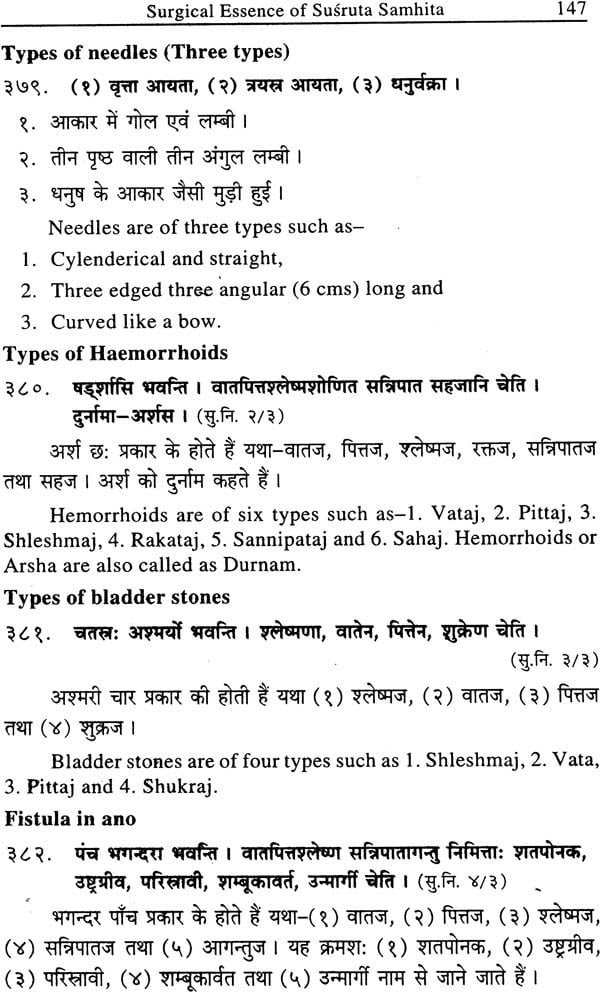
Surgical Essence of Susruta Samhita
Book Specification
| Item Code: | NAN439 |
| Author: | Prof. K. K. Thakral |
| Publisher: | CHAUKHAMBHA ORIENTALIA, Varanasi |
| Language: | Sanskrit Text With English Translation |
| Edition: | 2019 |
| ISBN: | 9788176373807 |
| Pages: | 176 |
| Cover: | Paperback |
| Other Details | 8.5 inch X 5.5 inch |
| Weight | 170 gm |
Book Description
Dr. K.K. Thakral was born on 1938 in the village Sobowal, Distt. Sargodha, now in Pakistan. The family shifted to Yamuna Nagar, Haryana during partition of the country. After passing intermediate with science he graduated from state Ayurvedic college, Lucknow in 1964 obtaining Bachelor of Ayurveda with Modern Medicine and Surgery (B.A.M.S.) degree from Lucknow University in First position. He obtained his P.G. degree D. Ay.M (Shalya Shalakaya, i.e. surgery and E.N.T.) from B.H.U. Varanasi in 1968 in first position. He served as lecturer, reader, Professor (Shalya) in various state Ayurvedic colleges of U.P. Then he served as Principal and Dean, Faculty of Ayurveda, Kanpur University for 5 years. He was invited to work as Asstt. Research Surgeon, Surgeon, Deptt. of Surgery, University of California, San Francisco, School of Medicine, U.S.A. for two years and conducted higher research in wound healing. He worked as Director, Ayurveda and Unani and Director Ayurveda and Unani (Syllabus valuation) during 1995-1996, U.P.
He has published 56 research papers out of which 12 are in foreign journals. He has guided Ph. D. And M.D. thesis, and has published a book entitled ‘Shalya tantra ke siddhanta’. He was moderator, Publication division C.C.I.M. New Delhi. He worked as nember of Ayurved advisory committee, U.P.,C.C.I.M. New Delhi, Education committee C. C. I .M., National task force on Kshar Sutra, Dept. of AYUSH, Deptt. of Ayush, Ministry of Health & F.W. govt. of India. He worked as expert member, Public Service commission, Uttra Khand, and B.H.U. Varanasi. He has delivered 52 guest lectures during C.M.E. and R.O.T.P. programmes.
He was awarded Ayurved Ratnakar in 1991, Ayurved Brahaspati in 1992 and National Herbal Protection award, Global open university in 2010.
He represented India during International conference, Juntendo University, Japan in 1992 and also was Chief guest Japan Ayurved Society in 1992.
He has renderd social services in Bronchial asthma relief camps-47. Handicapped service camps-4 and Eye relief camps-15.
He has been awarded fellow of International College of Angiology, U.S.A. 1979, Fellow of Academy of Indian Medicine-B.H.U.-1997 and Fellow of Rashtriya Ayurved Vidyapeeth-(E.R.A.V.) New Delhi-2001, and worked as GURV for 3 years.
After his retirement as Director, Ayurveda and Unani, U.P. he is running his own specialized Kshar Sutra Clinic and serving the humanity.
It gives me immense pleasure to write the foreword of the book entitled "Surgical Essence of Sushruta Samhita" written by Prof. K.K. Thakral, who has been a teacher, researcher and administrator.
"Sushruta" the great surgeon of ancient India lived and practiced surgery around 7000 years back. He propounded and established the principles and philosophy of Surgery. His teachings on treatment of different kinds of wounds including war wounds, asepsis, antisepsis, ways of spread of infection, fractures, dislocations piles, Fistula in ano, urinary bladder stones, and caesarean section are of great importance.
He was the first person to perform rhinoplasty and repair of cut ears and so gave Plastic surgery to the world and that is why he is known as "Father of Surgery" and rightly so.
In the present times surgery has made a huge progress with the help of anaesthesia, technology and newer instruments which have made it possible to reach all the organs of the body. If analysed carefully all these developments are based on the surgical principles and philosophy as described by Sushruta.
Prof. Thakral with his vast experience has tried to bring out all those' i1ilbdrtant' facts in his book. The book contains important Shlokas with their translation both in English and Hindi which will help the-readers to understand and comprehend the subject easily. The modern day surgeons in India and abroad would also be benefited by understanding the knowledge embedded in Sushruta Samhita.
I congratulate Prof. Thakral for-this scholarly work and hope he would keep exploring the treasure of knowledge present in ancient medical books for the benefit of humanity.
I am happy to bring out this short compilation of Susruta' s verses on important topics in Surgery. It is hoped that it will help the Post Graduate students of Shalya Tantra as well as teachers to review the subject. I wish that Post Graduate Students remember these Shlokas by heart and am sure that if they do so they shall never fail in the teaching and practice of their surgical skill. Needless to mention that the compilation is by no means complete. However efforts have been made to include all important aspects. In future further improvements in arrangement of the matter and inclusion of the matter left out will be made. I have every hope that this short compilation will help the reader to have a bird's eye view of the vast treasuers of knowledge locked in our ancient Samhita and will initiate him to dive deeper in the subject to bring out new suggestions for enriching the science and practice of surgery as a whole. I owe my gratitude to my teachers (late) Dr. P.J. Deshpande, (Late) Dr. L.M. Singh, (Late) Dr. P.S. Shankaran, who always stressed for studying Sushruta Samhita.
Contents
| 1 | Definition of vrana (wounds) | 1 |
| 2 | 2nd Definition of vrana | 1 |
| 3 | Classification of vrana (wounds) | 2 |
| 4 | Examination | 2 |
| 5 | Trividh pareeksha (Three methods of examination) | 2 |
| 6 | Normal shapes of curable wounds | 3 |
| 7 | Seats of vrana (wounds) | 3 |
| 8 | Detail of seats | 3 |
| 9 | Odors | 4 |
| 10 | Detail of odors | 4 |
| 11 | Detail of odors | 5 |
| 12 | Fourteen types of wound sischarges, 12-A, wound discharges according to the site of wounds are as follows | 5 |
| 13 | Colours | 7 |
| 14 | Pain, 14-A, Vatik Pain, 14-B, Paittik pain, 14-C, Shleshmic pain, 14-D, Sanipattik pain. | 0 |
| 15 | Types of dushta vrana | 9 |
| 16 | Signs and symptoms of unclean wound | 11 |
| 17 | Signs and symptom of unclean wound | 11 |
| 18 | Shuddha vrana (clean wound) | 11 |
| 19 | Shuddha vrana (clean wound) | 11 |
| 20 | Shuddha vrana (A clean wound) | 12 |
| 21 | Ruhyaman vrana (healing wound) | 12 |
| 22 | Rudha vrana (healed wound) | 12 |
| 23 | Factors retarding wound healing | 13 |
| 24 | Factors retarding wound healing | 13 |
| 25 | Factors retarding wound healing | 14 |
| 26 | Complications of wounds and of the wounded | 14 |
| 27 | Complications of wounds and of the wounded | 14 |
| 28 | Complications of wounds and of the wounded | 15 |
| 29 | Prognosis of wounds, curable wounds | 15 |
| 30 | Curable wounds | 16 |
| 31 | Wounds curable with difficulty | 16 |
| 32 | 32-A, Wound curable with difficulty | 16 |
| 33 | Incurable wounds | 17 |
| 34 | Incurable wounds | 17 |
| 35 | Incurable wounds | 17 |
| 36 | Incurable wounds | 18 |
| 37 | Classification of traumatic wounds | 18 |
| 38 | Classification of traumatic wounds | 18 |
| 39 | Shapes of wounds | 18 |
| 40 | Shapes of wounds | 18 |
| 41 | Chhinna vrana (excised wound) | 19 |
| 42 | Varieties of china vrana | 19 |
| 43 | Bhinna vrana (Penetrating wound) | 20 |
| 44 | Abdominal injury | 20 |
| 45 | Abdominal injury | 20 |
| 46 | Abdominal injury | 21 |
| 47 | Viddha vrana (punctured wound) | 21 |
| 48 | Varieties of viddh vrana | 21 |
| 49 | Varieties of viddha vrana | 21 |
| 50 | 50-A, kshat vrana (Incised wound) | 22 |
| 51 | Pichchita vrana (lacerated wound) | 23 |
| 52 | Varieties of pichchita vrana | 23 |
| 53 | Ghrishtaa vrana (abrased wound) | 23 |
| 54 | Special characters of pichchita and ghrishta vrana | 23 |
| 55 | Prognosis of injuries according to the characters of discharges | 24 |
| 56 | Abdominal injury without complication | 24 |
| 57 | Role of dosha during ripening of shofa | 25 |
| 58 | Features of aama shofa | 25 |
| 59 | Features of aama shofa | 25 |
| 60 | Features of pachyamana shofa | 25 |
| 61 | Features of pakwa shofa | 26 |
| 62 | Do's for the wounded | 27 |
| 63 | Do's for the wounded | 27 |
| 64 | Do's for the wounded | 28 |
| 65 | Do's for the wounded | 28 |
| 66 | Harmful diets for the wounded | 28 |
| 67 | 67A. Harmful diets for the wounded | 29 |
| 68 | 68-A, Harmful diets and other factors for the wounded | 30 |
| 69 | Beneficial diets for the wounded | 31 |
| 70 | Beneficial diets for the wounded | 31 |
| 71 | Beneficial diets for the wounded | 31 |
| 72 | Beneficial diets for the wounded | 31 |
| 73 | Sixty procedures in the management of wounds | 32 |
| 74 | General qualities of a wound | 33 |
| 75 | Line of management of traumatic wounds | 34 |
| 76 | Line of management of wounds | 34 |
| 77 | Qualities of ideal incision | 34 |
| 78 | Importance of knowledge of stages of vrana-shofa | 35 |
| 79 | Burns; Materials used for cauterization | 35 |
| 80 | Different forms of therapeutic burns | 36 |
| 81 | Clinical features of different degree of burns | 36 |
| 82 | Clinical features of different degree of burns | 36 |
| 83 | Stages of accidental burns | 37 |
| 84 | Common treatment for all burns | 37 |
| 85 | Common treatment for all burns | 37 |
| 86 | Treatment of samyagdagdh | 37 |
| 87 | Treatment of atidagdh | 38 |
| 88 | Kshar; definition | 38 |
| 89 | Qualities of ideal incision | 38 |
| 90 | Varieties | 39 |
| 91 | Indications | 39 |
| 92 | Internal use | 39 |
| 93 | Signs of ideal kshar patan (application of Kshar) | 40 |
| 94 | Signs of ideal kshar patan (application of Kshar) | 40 |
| 95 | 95-A, antidote | 40 |
| 96 | Deficient therapeutic burns | 40 |
| 97 | Complications of wounds and of the wounded | 41 |
| 98 | Complications of wounds and of the wounded | 41 |
| 99 | Complications of wounds and of the wounded | 41 |
| 100 | Advantages of ksharkarma | 42 |
| 101 | Bhagna (fractures); functions of bone | 43 |
| 102 | Varieties of bones | 43 |
| 103 | Effect of trauma | 43 |
| 104 | Causes of fractures | 43 |
| 105 | Types of skeletal injuries | 44 |
| 106 | Treatment of compound | 44 |
| 107 | Types of fractures | 45 |
| 108 | Signs and symptoms | 45 |
| 109 | Typical clinical features of fractures & of joint injuries | 45 |
| 110 | Vishisht | 46 |
| 111 | Vivartit | 46 |
| 112 | Avkhshipt | 46 |
| 113 | Atikhshipt | 46 |
| 114 | Tiryak khshipt | 47 |
| 115 | Karkatak | 47 |
| 116 | Ashwakarna | 47 |
| 117 | Choornit | 47 |
| 118 | Pichchita vrana (lacerated wound) | 47 |
| 119 | Asthichhallit | 47 |
| 120 | Vellit | 48 |
| 121 | Majjanugat | 48 |
| 122 | Atipatit | 48 |
| 123 | Vakra | 48 |
| 124 | Chhinna | 48 |
| 125 | Patit | 48 |
| 126 | Sphutit | 49 |
| 127 | Bad prognosis | 49 |
| 128 | Prognosis | 50 |
| 129 | 129-A; Prognosis | 50 |
| 130 | Treatment (first aid) | 50 |
| 131 | Principles of manipulation | 51 |
| 132 | Four principles management of skeletal injuries | 51 |
| 133 | Splinting material | 52 |
| 134 | Immobilization, Do' s & Don'ts | 52 |
| 135 | Principles of treatment of compound fracture | 52 |
| 136 | Loose bone | 53 |
| 137 | Infection | 53 |
| 138 | Management of malunion | 53 |
| 139 | Management of malunion | 54 |
| 140 | Use of healthy limb for splintage | 54 |
| 141 | Gradual weight bearing exercises | 54 |
| 142 | Gradual weight bearing exercises | 55 |
| 143 | Treatment of avulsed ear | 55 |
| 144 | Beneficial procedures | 55 |
| 145 | Criteria of ideal healing | 56 |
| 146 | 146-A; Do's and Don'ts | 56 |
| 147 | Plastic surgery; varieties of ear repair | 57 |
| 148 | Basic principles of ear plasty | 57 |
| 149 | If one karnapali (pinna) is absent | 57 |
| 150 | If both karnapali (pinna) are absent | 58 |
| 151 | If outer pali (pinna) is bigger or smaller | 58 |
| 152 | If remnant pinna is big and spread | 58 |
| 153 | Indications | 59 |
| 154 | Contraindications for repair | 59 |
| 155 | Operative procedure | 59 |
| 156 | Operative procedure | 61 |
| 157 | Don'ts in post operative period | 62 |
| 158 | Complication of too early physiotherapy | 62 |
| 159 | Complications of too early physiotherapy | 63 |
| 160 | Rhinoplasty | 63 |
| 161 | Detachment of pedicle and correction of repair | 64 |
| 162 | Ideally healed ear | 64 |
| 163 | Instruction for surgeons | 65 |
| 164 | BANDH (bandaging); bandaging materials. | 65 |
| 165 | Varieties of bandages | 66 |
| 166 | Indications | 67 |
| 167 | Kosh bandage | 67 |
| 168 | Daam bandage | 67 |
| 169 | Application of daam bandage | 67 |
| 170 | Swastik bandage | 67 |
| 171 | Annuvellit bandage | 68 |
| 172 | Mutoli (pratoli) bandage | 68 |
| 173 | Mandal bandage | 68 |
| 174 | Sthagika bandage | 68 |
| 175 | Yamak bandage | 68 |
| 176 | Khatwa bandage | 68 |
| 177 | Cheen bandage | 68 |
| 178 | Vibandh bandage | 68 |
| 179 | Vitaan bandage | 69 |
| 180 | Gophana bandage | 69 |
| 181 | Panchangi bandage | 69 |
| 182 | Utsang bandage | 69 |
| 183 | Varieties | 69 |
| 184 | Ideal bandage | 70 |
| 185 | Advantages of bandaging | 70 |
| 186 | Frequency of change of bandages | 71 |
| 187 | Advantages of bandaging | 71 |
| 188 | 188-A situations to avoid bandaging | 0 |
| 189 | Urinary stones; Anatomical position and relations | 72 |
| 190 | Functions of bladder | 73 |
| 191 | Functions of bladder | 74 |
| 192 | Predisposing factors | 74 |
| 193 | Pathogenesis | 75 |
| 194 | Varieties | 75 |
| 195 | Signs and sympoms | 75 |
| 196 | Signs and symotoms | 76 |
| 197 | Symptoms of vataja Asjmari | 77 |
| 198 | Symptoms of pittaja asjmari | 77 |
| 199 | Symptoms of kaphaj ashmari | 77 |
| 200 | Symptoms of shukraj ashmari | 78 |
| 201 | Complications | 78 |
| 202 | Complications | 78 |
| 203 | Prognosis | 78 |
| 204 | Prognosis | 79 |
| 205 | Prognosis | 79 |
| 206 | Principle of management; treatments | 79 |
| 207 | Sequence of symptoms during management | 79 |
| 208 | Indications for surgical treatment | 80 |
| 209 | Seriousness of prognosis | 80 |
| 210 | Caution while operating | 81 |
| 211 | Operative procedure | 81 |
| 212 | Specific indications; chhedan | 82 |
| 213 | Instruments used for chhedana and bhedana | 83 |
| 214 | General indications of bhedan | 83 |
| 215 | Specific indications; chhedan | 84 |
| 216 | General indications of lehan | 85 |
| 217 | 217-A and 217-B; specific indications | 0 |
| 218 | Material used for lekhen | 86 |
| 219 | 219-A Specific indications | 0 |
| 220 | 220-A, 220-B; Indications for vyadhan (puncturing) | 87 |
| 221 | 221-A, 221-B; indications of Eshan | 0 |
| 222 | Probing the wound | 88 |
| 223 | Probing the wound | 89 |
| 224 | Two types of probes | 89 |
| 225 | Selective use of probe | 89 |
| 226 | Indications of Aaharan | 90 |
| 227 | 227-A, Specific indications | 90 |
| 228 | 228-A; Indications of Visravana (drainage) | 90 |
| 229 | Instruments for visravana | 91 |
| 230 | Indications of seevan (suturing) | 91 |
| 231 | Specific indications; chhedan | 92 |
| 232 | Specific indications; chhedan | 92 |
| 233 | Contraindications of seevan | 92 |
| 234 | Contraindications of seevan | 93 |
| 235 | 235-A; suturing technique | 93 |
| 236 | Suture materials | 93 |
| 237 | Types of sutures | 94 |
| 238 | Ideal stitches | 94 |
| 239 | Blood; definition of blood | 94 |
| 240 | Definition of blood | 95 |
| 241 | Blood depots | 95 |
| 242 | Quantity | 95 |
| 243 | Importance of blood | 95 |
| 244 | Diseases due to blood impurities | 96 |
| 245 | General principle of treatment | 97 |
| 246 | Contra indications for blood letting | 97 |
| 247 | Two methods of blood letting | 98 |
| 248 | Choice of method with justification | 98 |
| 249 | Choice of method with justification | 99 |
| 250 | Contraindications for venesection | 99 |
| 251 | Contraindications for venesection | 99 |
| 252 | Contraindications for venesection | 99 |
| 253 | Size of puncture according to site lesion | 100 |
| 254 | Blood letting time (time when blood letting should be done) | 100 |
| 255 | Blood letting time | 100 |
| 256 | Quantiy | 101 |
| 257 | Ideal blood letting test | 101 |
| 258 | Conditions when blood does not flow | 101 |
| 259 | 259-A; Conditions when blood does not flow | 102 |
| 260 | Four principles of controlling bleeding | 102 |
| 261 | Action of four principles | 103 |
| 262 | Action of four principles | 103 |
| 263 | Action of four principles | 103 |
| 264 | When to stop visravan | 103 |
| 265 | Ideal signs of blood letting | 104 |
| 266 | Importance of venesection | 104 |
| 267 | Advantages of blood letting | 104 |
| 268 | Method and procedure | 104 |
| 269 | Method and procedure | 105 |
| 270 | Jalauka | 105 |
| 271 | Poisonous | 106 |
| 272 | Non poisnous | 106 |
| 273 | Contra indications of leech | 106 |
| 174 | Experts in use of jalauka | 106 |
| 275 | Pathology of nadi vrana | 107 |
| 276 | Management | 107 |
| 277 | Application of kshar sutra | 108 |
| 278 | Applications of kshar sutra | 108 |
| 279 | Application of kshar sutra | 108 |
| 280 | Definition of bhagandra | 109 |
| 281 | Types of bhagandra | 109 |
| 282 | Types of bhagandra | 109 |
| 283 | Types of bhagandra | 109 |
| 284 | Examination of bhagandra | 110 |
| 285 | Pracheen and arvacheen | 110 |
| 286 | Operative procedure | 111 |
| 287 | Shatponak | 111 |
| 288 | Ushtragreeva | 112 |
| 289 | Parisravi | 113 |
| 290 | Patikshepi | 114 |
| 291 | Piju | 114 |
| 292 | Arsho-bhagandara | 114 |
| 293 | Arsho-bhagandara | 114 |
| 294 | 294-A; Shambukavarta | 115 |
| 295 | Unmargi | 116 |
| 296 | Management in general | 117 |
| 297 | Treatment of a burst Abscess or when it is in ripen condition | 117 |
| 298 | 298-A; treatment of shatponak | 117 |
| 299 | Ushtragreeva | 118 |
| 300 | Parisravi | 119 |
| 301 | Parikshepi | 120 |
| 302 | Arshobhagandra | 120 |
| 303 | Care in children | 120 |
| 304 | Unmargi | 120 |
| 305 | To relieve pain | 121 |
| 306 | Miscellaneous; Dose of medicine | 122 |
| 307 | Protection of vrana from contamination | 122 |
| 308 | Spread of diseases | 123 |
| 309 | Good medical man | 123 |
| 210 | Good medical man | 124 |
| 311 | Good medical man | 124 |
| 312 | Good medical man | 124 |
| 313 | A vaidya who does not know the procedures | 125 |
| 314 | Ubhayagaya vaidya (learned and skilled) | 125 |
| 315 | Ubhayagaya vaidya (learned and skilled) | 125 |
| 316 | A careless medical student | 125 |
| 317 | Qualities of a surgeon | 126 |
| 318 | Qualities of a surgeon | 126 |
| 319 | Qualities of a surgeon | 126 |
| 320 | Qualities of a surgeon | 127 |
| 321 | Unskilled surgeon | 127 |
| 322 | Surgeon with qualities | 127 |
| 232 | Surgeo with qualities | 128 |
| 324 | Qualities of assistants/nursing staff | 128 |
| 325 | Relation with the patient | 129 |
| 326 | Arbud (tumour); complete eradication of arbudas | 129 |
| 327 | Relation of dosha prakopa and age | 129 |
| 328 | Substitutes of agni and kshara | 130 |
| 329 | Assessment of bala | 130 |
| 330 | Pathogenesis of vyadhi | 130 |
| 331 | Pathogenesis of vyadhi | 131 |
| 332 | Change of management | 131 |
| 333 | Definition of shalya | 132 |
| 334 | Definition of shalya | 132 |
| 335 | Whole course of surgery | 132 |
| 336 | Whole course of surgery | 133 |
| 337 | Surgical manoeuvre; No food before operation | 133 |
| 338 | Definition of Yantra | 133 |
| 339 | Number of Yantra (blunt instruments essential in operation theatre) | 134 |
| 340 | Importance of kankamukha instrument, 340-A; Number of sharp instruments. | 134 |
| 341 | Definition of shopha (Inflammatory swelling) | 134 |
| 342 | Diagnosis of presence of shalya (foreign body) 342-A; Marmas (vital points) | 135 |
| 343 | Sadya pranhar | 136 |
| 344 | Kalantar pranhar | 136 |
| 345 | Vishalyaghna | 136 |
| 346 | Vaikalyakar | 137 |
| 347 | Rujakar | 137 |
| 348 | Time effect on injury | 137 |
| 348 | Kriyakal | 137 |
| 350 | Kriyakal | 138 |
| 351 | Prognosis of vrana | 138 |
| 352 | Direction of shalya | 138 |
| 353 | 353-A, 353-B; Fate of shalya | 139 |
| 354 | Types of shalya | 139 |
| 355 | Method of extraction of shalya | 140 |
| 356 | Careful use of procedures (Agni, Kahar) | 141 |
| 357 | Groups of drugs & indications, aragvadhadi | 141 |
| 358 | Varunadi | 141 |
| 359 | Veertarvadi | 141 |
| 360 | Sursadi | 141 |
| 361 | Priyangu and others | 141 |
| 362 | Naygrodhadi | 141 |
| 363 | Lakhshadi | 142 |
| 364 | Apachi | 142 |
| 365 | Arbuda | 142 |
| 366 | Adhyarbuda | 143 |
| 367 | Dwirarbuda | 143 |
| 368 | Galganda | 143 |
| 369 | Shastras | 144 |
| 370 | Burns; Materials used for cauterization | 144 |
| 371 | Leeches | 144 |
| 372 | Shopha | 145 |
| 373 | Vranalepa | 145 |
| 374 | Types of diseases | 145 |
| 375 | Types of diseases | 145 |
| 376 | Surgical manipulation | 146 |
| 377 | 377-A; types of stitching | 146 |
| 378 | Stitching materials | 146 |
| 379 | Types of needles (three types) | 147 |
| 380 | Types of hemorrhoids | 147 |
| 381 | Types of bladder stones | 147 |
| 382 | Fistula in Ano | 147 |
| 383 | Types of udaras | 148 |
| 384 | Types of vidradhi | 148 |
| 385 | Types of visarpa | 148 |
| 385 | Types of visarpa | 148 |
| 386 | Types of nadi vrana | 148 |
| 387 | Types of stanrogas | 149 |
| 388 | Types of granthi | 149 |
| 389 | Types of arbuda | 149 |
| 390 | Types of vriddhi | 150 |
| 391 | Kshudrarogas | 150 |
| 392 | Types of bhagna (dislocation) | 150 |
| 393 | Types of bhagna (fractures) | 150 |
| 394 | Mukhrogas | 151 |
| 395 | Seat of mukh rogas | 151 |
| 396 | Number of marmas | 151 |
| 397 | Types of marmas according to post injury effect, 397-A-Basti marma | 151 |
| 398 | Precaution during operations | 152 |
| 399 | Postoperative management | 153 |
| 400 | Definition of sharkara (gravel) | 153 |
| 401 | Signs and symptoms | 153 |
| 402 | Signs and symptoms | 153 |
| 403 | Complications | 154 |
| 404 | Surgical management | 154 |
| 405 | Basic surgical procedures, general indications | 154 |
| 406 | Excision | 155 |
| 407 | Every substance in the world is a medicine | 155 |
| 408 | Importance of food | 156 |
Sample Pages

